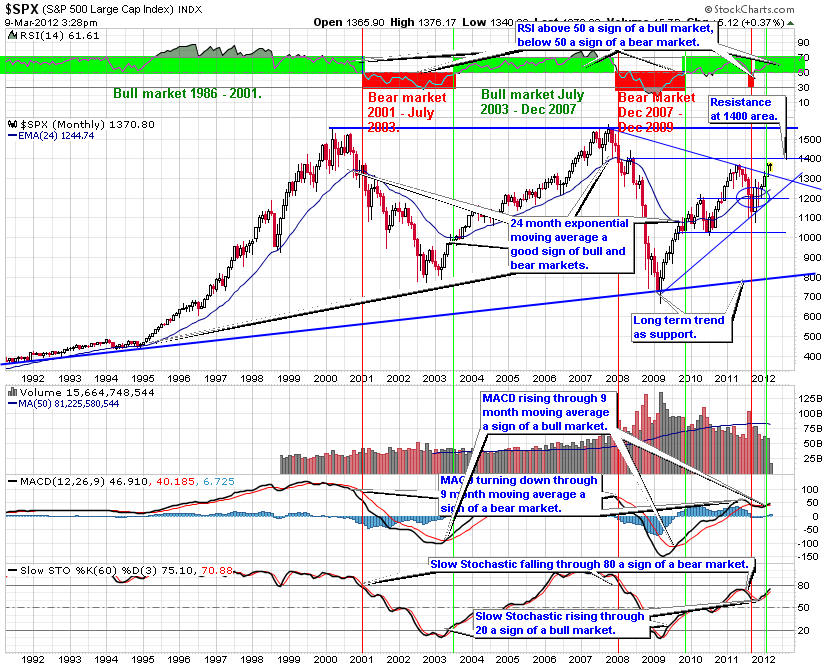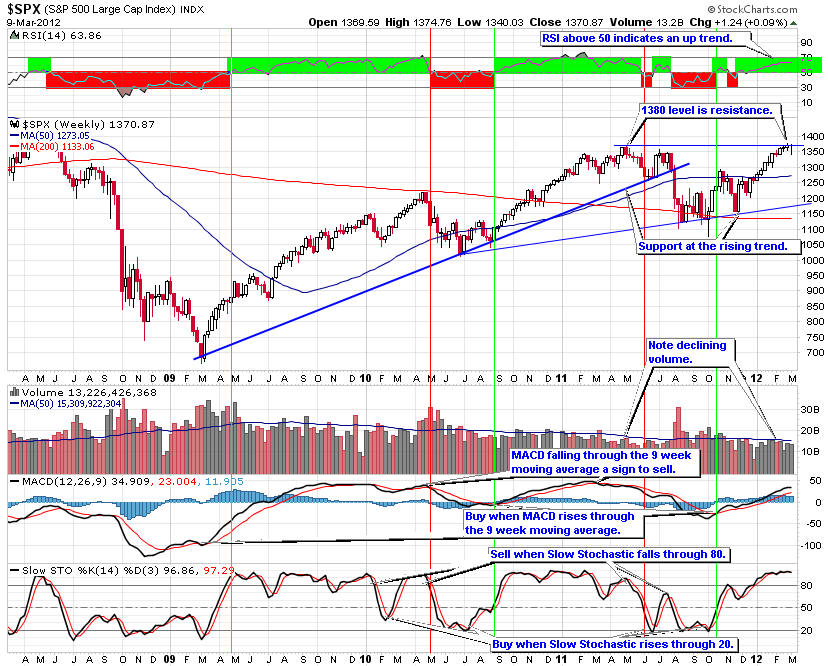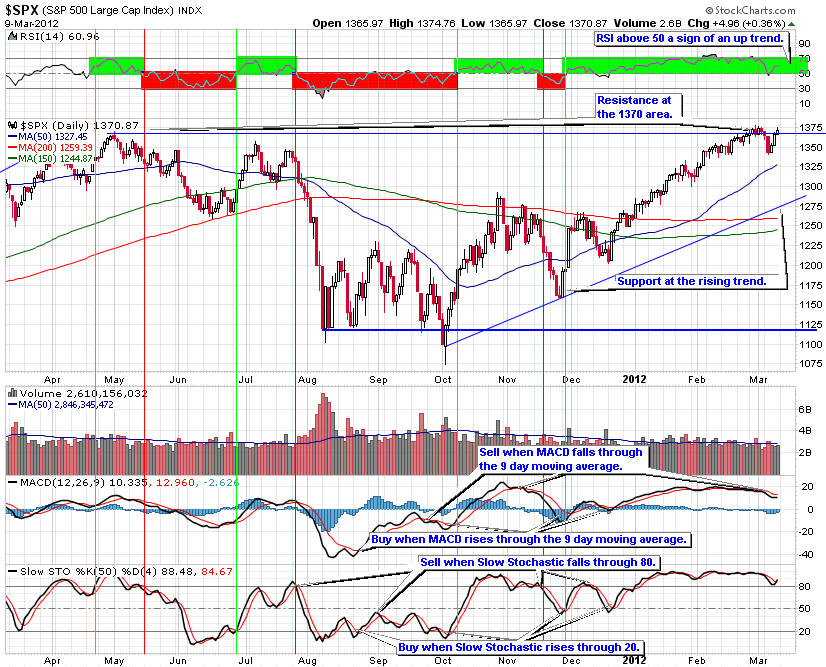

Analyzing monthly stock market trends uses the S&P 500 charts to indicate important trend lines. Trend following is a proven strategy to beat the market and grow your stock portfolio. Technical analysis provides the tools to analyze and identify trends in the stock market. Since the S&P 500 trend line chart is the one used by professional traders for their analysis, it is important to understand how it is performing.
The analysis of the S&P 500 trend line starts with the 20-year monthly view of the S&P 500 chart. Next, we examine the weekly chart of the S&P 500 trends to get a shorter-term view. Finally, we analyze the one-year daily chart of the S&P 500 trends to get an even shorter-term view. On each version of the charts of the S&P 500 trend line, the view and the value of the indicators change, as we move from a monthly to a weekly and then a daily chart.
Starting with the monthly view of the S&P 500 trend chart, the bull market of the last five years turned down, as the index fell below the 24-month exponential moving average. The Relative Strength Indicator (RSI) is below 50, indicating a downtrend is in place. The Moving Average convergence Divergence (MACD) is also below zero, a sign stock market trend has reversed and we have entered a bear market. Finally, the Slow Stochastic fell through zero, another sign of a bear market.
The analysis of the monthly trends of the S&P 500 chart shows we remain in a bear market with key resistance at the 24-month exponential moving average. In addition, support at the 25 year rising S&P 500 trend line has been tested and held, so far. However, the Slow Stochastic is testing the 20 level. If it is able to stay above 20, it is an early buy sign.

The three-year weekly S&P 500 trend line chart shows more closely the transition from a bull to a bear stock market. So far, the descending trend line and the 50-week moving average are the primary resistance levels for this view of the bear market.
Earlier this year the S&P 500 fell through support at the 800 level down to the 650 area. The S&P 500 trend then reversed course, pushed through the 800 level and then the small descending trend line. There is resistance at the 940 area that is being tested. Just above there the 970 area offers additional resistance.
From the chart, it looks like the S&P 500 trend line may rise through these resistance levels and test the 50-week moving average. It will be several weeks before we see such a test. The falling volume is a concern. If volume can rise above the weekly average, it is a good sign that the up trend can continue.
RSI is above 50, a sign of an up trend. The MACD turned up through the nine-week moving average, a buy sign and it is still trending up, which is a positive sign. In addition, the MACD showed positive divergence indicating the uptrend would begin. Slow Stochastic is above 80, where it will eventually turn down, giving a sell sign.
Long term, the trend line of the S&P 500 chart is still down. The weekly pattern indicates the S&P 500 trend line indicates to rise with the most likely case is we will see a test of the 50-week moving average.

The daily S&P 500 is a bit complicated as several indicators say the market is overbought, yet the rally that began in early March continues. Resistance at the 940 level and the 200-day moving average is being tested. For the rally to keep going we need to see the S&P 500 close above these levels for several days in a row.
Volume has been trailing off, which is not a good sign for the market to keep going up. Watch for above average buying volume as a sign the S&P 500 will continue it's up trend. Otherwise, we should expect a pull back.
RSI is above 50 indicating an up trend. The MACD is at a high point it turned down through the 9-day moving average, a sell signal. However, the recent turn up has negated the earlier sell signal. The Slow Stochastic is above 80 where it will turn down giving a sell sign. These are the signs that the market is overbought, yet it can continue to rise for a while.
The daily chart of the S&P 500 is showing we are at an important transition point. If the index can sustain the move up, it could be a sign the current rally will continue for several more weeks at least. On the other hand, if the S&P 500 turns down, we are likely to see a pull back that could test important support levels below.

Given this analysis of the S&P 500 trend line charts, it is important to have your portfolio positioned for a bear market rally that might rise to the 970 area. If the S&P 500 trend line can reach this level, it will be time to add further down side protection and/or reduce your long positions. A rally to this level over the next few weeks increases the risk of a down turn as we remain in an overall bear market.
The charts of the S&P 500 trend line provide a good way for investors to align their portfolios with the overall market trends.
Bear market rallies offer investors a good time to buy stocks and ETFs in leading sectors. Look to buy on dips in the price of the S&P 500 trend charts during a bear market rally. Be sure to use proper capital management techniques including trailing stops, protective put and covered call options. Once the rally ends take profits and reduce your long positions. Keep in mind, Warren Buffett's first rule of investing is to not loose money. Patience is key when markets are moving down.
Our Premium Members receive weekly analysis of market trends of all major indexes and industry sectors. They also receive frequent updates when conditions warrant, so they are prepared to trade and invest with the trend. Moreover, our stock and sector portfolios have beat the market every year since our inception in 2005. For 2009, our stock portfolio is up 8.9% for the year.
Try the free four week subscription to our Premium Members pages and receive:
If you decide to continue at the end of the four-week trial your subscription starts automatically. If you decide to cancel before the end of the trial, you will not be charged a thing. No risk, no obligation.
Give the Premium Membership a try. You have nothing to lose and a lot to gain and we have beat the market every year since our inception.